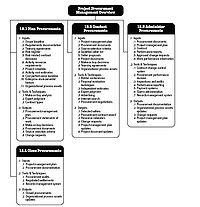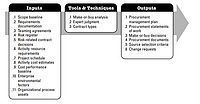Vico in digital environment
Contents |
Abstract
As the present situation is in the building industry, there is an ongoing tendency that the building project are getting more complex, this results in more detailed project descriptions from the building owner. This have created a big desire for trying and move the industry to a 100 % digital environment, where all buildings are constructed directly from the 3D model. I the light of the governments growth package from 2002 “vækst med Vilje”[1] was the construction industry on the agenda. The purpose was to create a higher productivity I the construction industry by moving towards a 100 % digital building environment.
But to be able to manage these highly complex building projects and building it 100 % digital from the 3D model, it is necessary for the project team to have a software tool that can help organize and manage the increased flow of information and degree of details.
When doing procurement on a building project. The contractor have to deliver a payment plan over the project. To do that the contractor traditionally sits down and calculate the amount of quantities within the different building task eg. A column. This will then be compare with the schedule to know when the building objects should be produced from the supplier and send to the construction site, to ensure that the object are delivered on time.
But as the payment plan and main schedule are made before the project are in the construction phase, this will often result in the payment plan and main schedule will be revised a certain number of times. In the construction industry project modifications is estimated to almost 10% [2]. of the total building cost. Therefore it is highly necessary that the project team have a tool that can help creating new procurement when there is a project modification.
In a project Management environment a tool is an aid that can help the project team to effectively manage different task or activities. These activities can be in some ways be related to some of the PMBOK subject groups; Integration, stakeholder, scope, recourses, time, cost, risk, quality and procurement. Some tools have a computer software, in this case VICO is a construction-oriented software that can be used in a digital environment and can help the project manager to perform different task or activities in a construction project.
This article will describe how procurement can be undertaken in a digital environment compared with the traditional ways of procurement described in the PMBOK[3].. How VICO as a digital tool can be used in the digital project environment aligned with PMBOK subject groups within procurement.
Big idea
Project procurement management handles the different processes that are highly important for the organisation to conduct when buying products or services that are necessary to deliver the desired result. As shown in figure 1 project procurement management can be divided into four processes that ensure a good procurement management between the buyers and suppliers of the project. Each of the four processes have a number of inputs, tools and techniques and a output. This will be explained in the following.
Figure 1: Project procurement management processes [3].Plan procurement
The first process in procurement management is the planning part. This process includes the documentation of different purchasing decision, the planned approach, and the beginning of identifying several possible suppliers as shown in figure 2
Figure 2: Input, Tools & Technique and outputInput Scope baseline this gives a basic understanding on the specific requirements and criteria for the given project. Requirements documentation shall include which criteria's there have been discussed through the planning of the project. Teaming Agreements sets the boundaries for the arrangements between the parts in the project. This will help decide the roles between the building owner and the supplier. Risk register involves information associated to the identified risks which leads to the next input. Risk contract decision here the parts shall make different contracts including aspects such as insurance, this ensure each project team know their responsibilities. Activity resource requirements here the project team shall include individual requirements for the task. Project schedule here the project team shall include the time schedule for the construction, this will ensure that object is bought, produced and delivered on time. Activity cost estimates this is done for the project team to be able to evaluate the different solutions given from the suppliers. Cost performance baseline this together with the time schedule makes it possible for the project team to get overview of the present planned budget through the construction period. Enterprise environmental factors is focusing on the surrounding conditions, such as products that are available, how the supplier have performed in earlier construction project. This ensure a reliable supplier and makes sure that the given object is on the market at the needed time. Organisational process assets will ensure that if the organization itself, have a policy or guidelines that must be followed. If this is not the situation there can be created systems based on earlier projects.
Tools & Technique
Make or buy analysis this technique is a common known in management. Here the project team has to consider whether the objects shall be made internally or if a external supplier would be better. This must include all the different cost for either make or buy, and further the time related to either make or buy. This analysis itself Is very comprehensive and takes a lot of criteria into consideration, to be able to determine which option that is most affordable for the organisation. Expert judgment contains judgement used to evaluate the given inputs and outputs. The technique can help the project team develop the source selection criteria, for the project team to create or adjust the selection criteria's. This can also be used for determining the different procurements issues that are connected to the project. Contract types helps the project team to determine the risk between the parts, here several different contract types can be used to achieve the desired result. By choosing good contract types the risk connected to buying and selling will be reduced, as it already has been decided how the payment shall proceed through the project time.
Outputs
From the planning process the project team will now get a number of outputs, that will make It possible for the project team to continue the procurement process and start conducting process. The outcome is; Procurement management plan is an assembly of the inputs and are based on the certain needs within the project. It explains how the different procurement planning process shall be used from both the development of the documents to the contract closures. This will often provide a guidance for the given inputs. Procurement statements of work (SOW) is the outcome from the scope baseline. The SOW explains the procurement objects in an acceptable detail level, that makes it possible for the supplier to decide whether if they can deliver the given object. The SOW can have a different level of detail, based on the supplier needs or the chosen contract type. The information that can be include in the SOW are details like; quantities, quality, location or other requirements that are specific to the project. The SOW will in any construction project be revised through the process until the procurement has be signed a contract award. Make or buy decisions is the output from the analysis technique make or buy and results in a document, describing which objects or task that needs to be required from either internally or externally. Procurement documents creates documents that are used to solicit solutions from the different suppliers. Source selection criteria are often created for the project team to evaluate and rate the different supplier solutions. The Criteria are either subjective or objective and can e.g. only be rating the price. The number of criteria often gives the most desired result but if it is done to detailed it can reduce the number of suppliers that are able to the meet the criteria's.

